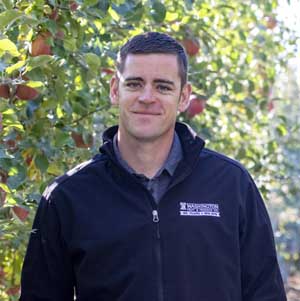
A 5-acre wildflower garden along a canal easement is part of Nick Plath’s organic pest control plan. The plants were specially chosen to attract beneficial insects to the orchards. (TJ Mullinax/Good Fruit Grower)
Washington Fruit and Produce Co. doesn’t do small. This year, the company’s first-ever certified organic harvest equaled close to 15 percent of their total overall volume.
“We went in in a big way after the ’14 crop, which was mostly not profitable for growers, but organic growers did better, so we transitioned a bunch of acres,” Dan Plath said. “We’ve learned some things, but when you see the size of the Grannies in the (organic block), you’ll see we still have some things to learn.”

Growing organically has been an exciting challenge so far, said Nick Plath, seen here in an organic Fuji block in the Columbia Basin. (TJ Mullinax/Good Fruit Grower)
In another organic block, where Fujis just days from harvest showed hints of russet from the coppers used for fire blight control, Nick Plath said that the organic learning curve has been both hard and exciting.
“It’s a fun challenge, but it’s frustrating sometimes when things aren’t going as you’d hope, knowing what you can accomplish conventionally, but that’s what you have to expect,” he said. “We try new things. I’ve got a little flower farm to try to attract beneficial insects to combat the insect pressure.”
His little flower farm is actually 5 acres, running along the easement for a now-buried irrigation canal. The area was seeded with a good-bug blend of strategic plants and supplemented with beneficial insect eggs, Nick said, adding that, like most of their organic program, it’s still being fine-tuned.
“It’s a tough thing to measure if it’s successful or not,” he said. But pest pressures appear lower in the blocks closer to the flower farm than those on the other side of the orchard.
Overall, the company opted to transition existing blocks into organic production once the trees had grown to fill their space, Nick said. But that means finding new solutions for production problems they previously solved with conventional products.
One such challenge exists in a Columbia Basin Granny Smith block planted on V-trellis in 2005, where the very shaded canopy shows the struggle to manage vigor without the plant bioregulator Apogee, and the fruit size has fallen.

This used to be Dan Plath’s trophy Granny Smith block, but after transitioning to organic production three years ago, he’s still learning how to best control canopy vigor without the plant bioregulator Apogee. (TJ Mullinax/Good Fruit Grower)
“This was our trophy Granny block,” Dan said. “All the blocks we transitioned, we really chose our best blocks. We figured if we were having problems farming them conventionally, it wasn’t going to get any easier farming them organically.”
It’s not the trophy block anymore, Dan said, eliciting a laugh from his uncle, Cliff Plath, during a tour of the orchard. They are trying delayed pruning and hedging at the tops of the trees to bring more light to the lower canopy and are considering root pruning. A trial of blossom thinning by hand showed strong promise for increasing fruit size, but they’ll have to decide if it’s worth the investment to do it on a larger scale next year.
The transition to organic is also apparent at the warehouse. The company’s new cold storage facilities have smaller rooms, one-third the size of regular storage, to store smaller batches of organic fruit, said Gilbert Plath, who recently joined the company and worked in receiving during apple harvest. They opted to use dynamic controlled atmosphere to store the organic apples.
“With organic rooms, you want to keep the oxygen as low as possible, until just before the apples can’t handle it,” he said, explaining how the HarvestWatch technology monitors fruit stress to guide storage conditions.
There is still a lot to fine-tune with their organics program, which they plan to expand with more orchards now in transition, including some Cripps Pink blocks that were hit hard by fire blight this year. But, there’s no turning back.
“We got into the organics business because if a customer wants 18 pallets of conventional and two pallets of organic, we’ll lose the 18 if we don’t have the two organic,” said company president Rick Plath. “We have to be there for our customers.” •
-by Kate Prengaman






Leave A Comment